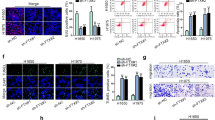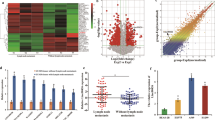Abstract
Lung adenocarcinoma (LUAD) patients exhibit poor prognosis, primarily due to metastasis. Emerging studies have demonstrated that long noncoding RNAs (lncRNAs) play critical roles in cancer progression and metastasis besides their physiological function. Here, we investigated the potential role of lncRNA MAF BZIP Transcription Factor G Antisense RNA 1 (MAFG-AS1) in LUAD metastasis by analyzing its expression in The Cancer Genome Atlas (TCGA) LUAD database, and its function in LUAD using in vitro and in vivo experiments. We performed bioinformatics analysis, western blotting, dual-luciferase reporter gene assay, RNA immunoprecipitation (RIP), and rescue assays to reveal the molecular mechanisms underlying MAFG-AS1 function. We observed augmented expression of MAFG-AS1 in LUAD tissues compared with normal adjacent tissues, and its association with poor prognosis. Furthermore, MAFG-AS1 overexpression promoted LUAD cell migration, proliferation, invasion, and epithelial mesenchymal transition (EMT). Besides, MAFG-AS1 also targeted miR-3196 directly by acting as an endogenous sponge, thereby rescuing the inhibition of SOX12, a target of miR-3196. Thus, the rescue assays demonstrated that MAFG-AS1 promotes cell migration, invasion, and EMT by modulating the miR-3196/SOX12 pathway. In conclusion, our findings suggest that MAFG-AS1/miR-3196/SOX12 axis regulates LUAD progression and is a potential therapeutic target for LUAD.








Similar content being viewed by others

Data Availability
Datasets used and analyzed during this study are available from the corresponding author upon reasonable request.
Abbreviations
- LUAD:
-
Lung adenocarcinoma
- TCGA:
-
The cancer genome atlas
- lncRNAs:
-
Long noncoding RNA
- EMT:
-
Epithelial-mesenchymal transition
- FBS:
-
Fetal bovine serum
- qRT-PCR:
-
Quantitative real-time polymerase chain reaction
- EdU:
-
5-Ethynyl-2′-deoxyuridine
- FISH:
-
Fluorescent in situ hybridization
- RIP:
-
RNA immunoprecipitation
- ceRNAs:
-
Competing endogenous RNAs
References
Kim, Y., Kim, H., Bang, S., Jee, S., & Jang, K. (2021). MicroRNA-130b functions as an oncogene and is a predictive marker of poor prognosis in lung adenocarcinoma. Laboratory Investigation, 101, 155–164.
Mullen, D. J., Yan, C., Kang, D. S., et al. (2020). TENET 2.0: Identification of key transcriptional regulators and enhancers in lung adenocarcinoma. PLoS Genetics, 16, e1009023.
Cao, X., Fang, X., Malik, W. S., et al. (2020). TRB3 interacts with ERK and JNK and contributes to the proliferation, apoptosis, and migration of lung adenocarcinoma cells. Journal of Cellular Physiology, 235, 538–547.
Zhan, J., Wang, P., Li, S., et al. (2019). HOXB13 networking with ABCG1/EZH2/Slug mediates metastasis and confers resistance to cisplatin in lung adenocarcinoma patients. Theranostics, 9, 2084–2099.
Tsoyi, K., Osorio, J. C., Chu, S. G., et al. (2019). Lung adenocarcinoma syndecan-2 potentiates cell invasiveness. American Journal of Respiratory Cell and Molecular Biology, 60, 659–666.
Pan, Q., Zhao, Z., Liao, Y., et al. (2019). Identification of an interferon-stimulated long noncoding RNA (LncRNA ISR) involved in regulation of influenza A virus replication. International Journal of Molecular Sciences. https://doi.org/10.3390/ijms20205118
Wang, X., Yang, J., Guo, G., et al. (2019). Novel lncRNA-IUR suppresses Bcr-Abl-induced tumorigenesis through regulation of STAT5-CD71 pathway. Molecular Cancer, 18, 84.
Guo, H., Feng, Y., Yu, H., Xie, Y., Luo, F., & Wang, Y. (2020). A novel lncRNA, loc107985872, promotes lung adenocarcinoma progression via the notch1 signaling pathway with exposure to traffic-originated PM25 organic extract. Environmental Pollution, 266, 115307.
Xu, Z. N., Wang, Z. X., Xu, L., et al. (2019). Long noncoding RNA SNHG14 exerts oncogenic functions in lung adenocarcinoma through acting as a sponge to miR-613. European Review for Medical and Pharmacological Sciences, 23, 10810–10817.
Liu, H., Han, L., Liu, Z., & Gao, N. (2019). Long noncoding RNA MNX1-AS1 contributes to lung cancer progression through the miR-527/BRF2 pathway. Journal of Cellular Physiology, 234, 13843–13850.
Yang, J., Qiu, Q., Qian, X., et al. (2019). Long noncoding RNA LCAT1 functions as a ceRNA to regulate RAC1 function by sponging miR-4715-5p in lung cancer. Molecular Cancer, 18, 171.
Xiao, M., Liu, J., Xiang, L., et al. (2020). MAFG-AS1 promotes tumor progression via regulation of the HuR/PTBP1 axis in bladder urothelial carcinoma. Clinical and Translational Medicine, 10, e241.
Feng, J., Wen, T., Li, Z., et al. (2020). Cross-talk between the ER pathway and the lncRNA MAFG-AS1/miR-339-5p/ CDK2 axis promotes progression of ER+ breast cancer and confers tamoxifen resistance. Aging, 12, 20658–20683.
Ruan, Z., Deng, H., Liang, M., et al. (2020). Downregulation of long non-coding RNA MAFG-AS1 represses tumorigenesis of colorectal cancer cells through the microRNA-149-3p-dependent inhibition of HOXB8. Cancer Cell International, 20, 511.
Wang, Q. Y., Peng, L., Chen, Y., et al. (2020). Characterization of super-enhancer-associated functional lncRNAs acting as ceRNAs in ESCC. Molecular Oncology, 14, 2203–2230.
Chu, J., Tao, L., Yao, T., et al. (2021). Circular RNA circRUNX1 promotes papillary thyroid cancer progression and metastasis by sponging MiR-296-3p and regulating DDHD2 expression. Cell Death & Disease, 12, 112.
Parolia, A., Venalainen, E., Xue, H., et al. (2019). The long noncoding RNA HORAS5 mediates castration-resistant prostate cancer survival by activating the androgen receptor transcriptional program. Molecular Oncology, 13, 1121–1136.
Zhu, S., Zhao, D., Li, C., et al. (2020). BMI1 is directly regulated by androgen receptor to promote castration-resistance in prostate cancer. Oncogene, 39, 17–29.
Huang, L., Lin, H., Kang, L., et al. (2019). Aberrant expression of long noncoding RNA SNHG15 correlates with liver metastasis and poor survival in colorectal cancer. Journal of Cellular Physiology, 234, 7032–7039.
Hu, X., Li, Y., Kong, D., Hu, L., Liu, D., & Wu, J. (2019). Long noncoding RNA CASC9 promotes LIN7A expression via miR-758-3p to facilitate the malignancy of ovarian cancer. Journal of Cellular Physiology, 234, 10800–10808.
Wang, Y., Zeng, X., Wang, N., et al. (2018). Long noncoding RNA DANCR, working as a competitive endogenous RNA, promotes ROCK1-mediated proliferation and metastasis via decoying of miR-335-5p and miR-1972 in osteosarcoma. Molecular Cancer, 17, 89.
Wang, L., Hu, F., Shen, S., et al. (2017). Knockdown of SOX12 expression inhibits the proliferation and metastasis of lung cancer cells. American Journal of Translational Research, 9, 4003–4014.
Acknowledgements
Not applicable.
Funding
Not applicable.
Author information
Authors and Affiliations
Contributions
QW performed the experiments, generated data, and data analysis and interpretation of data. JJ made substantial contributions to the conception and design of the present study. All authors contribute to the drafting and revision of the manuscript. All authors read, revised and approved the manuscript and agreed to be accountable for all aspects of the research in ensuring that the accuracy or integrity of any part of the work are appropriately investigated and resolved.
Corresponding author
Ethics declarations
Conflict of interest
The authors declare that they have no known competing financial interest or personal relationships that could influence the results reported in this manuscript.
Ethical Approval
All procedures performed in studies involving human participants were in accordance with the ethical standards of the Ethics Committee of Quzhou People’s Hospital Affiliated to Wenzhou Medical University and with the 1964 Helsinki declaration and its later amendments or comparable ethical standards. Animal studies were carried out in accordance with the National Institute of Health’s Guide for the Care and Use of Laboratory Animals, with the approval of the Animal Research Committee of Quzhou People’s Hospital Affiliated to Wenzhou Medical University.
Informed Consent
All patients provided written informed consent.
Additional information
Publisher's Note
Springer Nature remains neutral with regard to jurisdictional claims in published maps and institutional affiliations.
Supplementary Information
Below is the link to the electronic supplementary material.
12033_2022_455_MOESM1_ESM.tif
Supplementary Figure 1. miR-3196 mimics inhibits cell migration and invasion of LUAD cells. (A) Wound healing assay was used to determine the effect of miR-3196 mimics on cell migration. (B) Transwell assay was used to examine cell invasion. *P<0.05 and **P<0.01 (TIF 26154 kb)
12033_2022_455_MOESM5_ESM.xlsx
Table S4. The mRNAs are found to be positively correlated with the expression of lncRNA MAFG-AS1 (Spearman's Correlation>0.3) in the TCGA database (XLSX 1263 kb)
Rights and permissions
About this article
Cite this article
Wu, Q., Jiang, J. LncRNA MAFG-AS1 Promotes Lung Adenocarcinoma Cell Migration and Invasion by Targeting miR-3196 and Regulating SOX12 Expression. Mol Biotechnol 64, 970–983 (2022). https://doi.org/10.1007/s12033-022-00455-7
Received:
Accepted:
Published:
Issue Date:
DOI: https://doi.org/10.1007/s12033-022-00455-7



